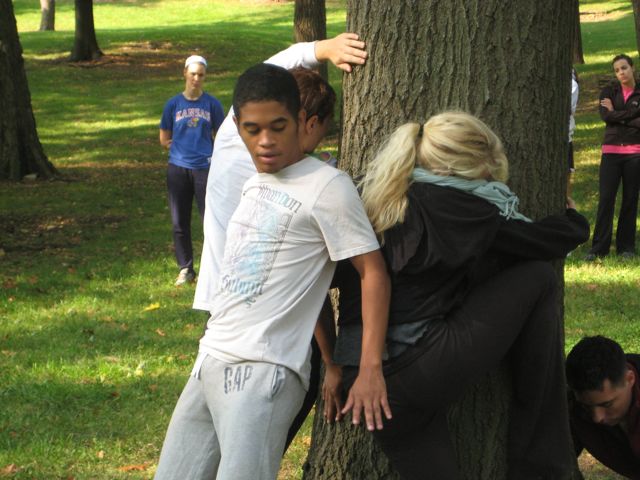
"Contact bases its language on the natural laws that govern motion (gravity, momentum, inertia, etc.). With these laws as our constitution we have no need for legislation" (Nancy Stark Smith, "A Subjective History of Contact Improvisation," ed. Ann Cooper Albright and David Gere, Taken by Surprise: A Dance Improvisation Reader"
3:10 - (Pete's video footage, 10.6.08; 22-31-33-4)
Michelle H. on the challenges and benefits of contact improvisation.
Feeling a connection to the tree and with other dancers.
41:00 (Michelle's video footage, 10.8.08)
00:10 - dancers around tree (Pete's video footage, 10.6.08; 22-31-33-1)
3:40 - (Pete's video footage, 10.6.08; 22-31-33-4)

Aside 1: Okay let me feel one of these trees, see what we're dealing with. It is surpisingly comfortable against my back. (from Sherrie's notes)
Note 5: I try a new way to write. Lean against the tree. Melt down it. Bark traction helps my thighs and butt hold me in a sitting position with my notebook on my knee. Comfortable briefly. Hell getting up. Getting up and down against these barky trees is more difficult than it looks. What the heck kind of trees are these? (from Sherrie's notes)
Some students are going for contact with the trees. While the dance is happening Michelle H. is giving color commentary to the observing group. One girl jumps straight into a tree and hugs it, which caused many laughs by the observers. Why was that funny? (chris's notes 9/29/08)
"As the movement language evolved and our perceptions became more articulated,the word images would change too,attempting to remain as flexible as the movements to which they were referring. It was important and fun to be able to discuss what was going on in the improvised dancing,but it also seemed important not to stifle the form's growth by oversolidifying the terminology surrounding it."--Nancy Stark Smith,"A Subjective History of Contact Improvisation."
"Contact Improvisation constantly challenges one's orientation: visual,directional,balance,and where in the body the consciousness is positioned." Steve Paxton,"Drafting Interior Techniques."
Smith quotes Steve Paxton on the purpose of Contact. He says "Just the pleasure of using your body is,I think, maybe the main point. And the pleasure of dancing with somebody in an unplanned and spontaneous way..." (Nancy Stark Smith, "A Subjective History of Contact Improvisation," ed. Ann Cooper Albright and David Gere, Taken by Surprise: A Dance Improvisation Reader,158)